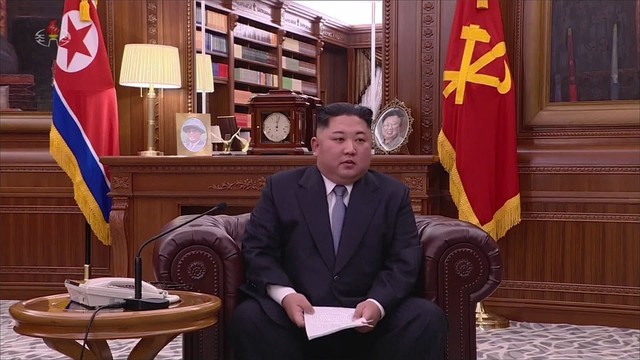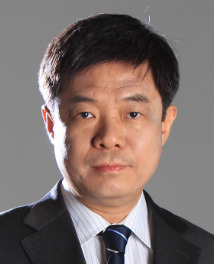Posted on : Jan.5,2019 12:56 KST
 |
|
North Korean leader Kim Jong-un gives his New Year’s address at the Workers’ Party of Korea headquarters in Pyongyang on Jan. 1. (Korean Central News Agency)
|
During a seminar last year, an expert on the North Korean nuclear issue said the end point of denuclearization talks would be “a situation where a peace regime is so firmly in place that it wouldn’t even matter if North Korea were hiding a few nuclear weapons.” We might describe it as an approach of “killing the North Korean nuclear issue through a peace process.” Quite a few of the participants vehemently objected. “Are you suggesting we accept a nuclear North Korea?” they asked, insisting that the North should not be allowed to have even a single nuclear weapon.
At another seminar, one of the experts said the history of nuclear states has been one where the weapons’ effectiveness has changed within about 15 years of their development – they have gone from being a means of attack to a means of defense. North Korea began full-scale nuclear development in the early 2000s, which means it would have reached this point by the second half of 2017. It was at that time when Pyongyang began referring to nuclear capabilities as the “sword of peace” rather than the “sword of omnipotence.”
Many of the experts at that seminar said North Korea was already a de facto nuclear state. In terms of denuclearization methodology, there are proponents of sanctions and negotiation, but their basic understanding of the situation is the same. Some voiced the view that “we can’t continue living with a nuclear North Korea,” or that “we need to somehow manage the North Korean nuclear program.” The North is estimated to have produced around 6kg of plutonium and 80kg of uranium each year. It is no longer simply “developing” nuclear weapons – it owns them.
Thae Yong-ho, an exiled former North Korean diplomat, recalled that at the time of the 1994 Agreed Framework in Geneva, no one believed the North Korean Foreign Ministry would live up to it. Externally, Pyongyang maintained that its aim was “denuclearization of the Korean Peninsula, not nuclear development,” he explained, but in reality it agreed to this in a last-ditch effort to buy time after Kim Il-sung died and North Korea was hit by major flooding. In retrospect, this doesn’t appear to have been too far off the mark.
Around 2005, then-South Korean President Roh Moo-hyun considered the idea of South Korea developing nuclear weapons. With the Sept. 19 agreement adrift, he proposed raising the issue of nuclear fuel, arguing that South Korea could not simply sit there and take a beating. His circle talked him out of it, pointing out that the US would never accept it. This was the recollection of then-Minister of Foreign Affairs Song Min-soon. Roh considered a “plan B,” but it was not to his liking.
As I listened to the New Year’s address Kim Jong-un delivered from his armchair, I found myself curious what he meant by “complete denuclearization.” His remarks about not making, testing, using, or proliferating nuclear weapons could be positively read as a promise to freeze the North’s nuclear program; alternatively, they could come across as a declaration of the North’s established nuclear capabilities.
Even if Kim’s “complete denuclearization” is a different proposition from the one the North put forth at the time of the Agreed Framework, we have no way of knowing the timeline or conditions. The least we can say is that it doesn’t appear to be the “swift surrender” envisioned by the West.
Calm and bold instead of optimistic or pessimistic
Whatever Kim’s intentions, there are no sure-fire solutions. We can’t really consider a “plan B” along the same lines as Roh Moo-hyun. The US will never acknowledge North Korea as a nuclear state. The difficulty of waging a preemptive attack against the North can be sensed in the way President Donald Trump stopped making open remarks along those lines. At the same time, we cannot give up the dream of a nuclear-free peninsula. The things Pyongyang most likely fears are tightly coordinated sanctions and strategic US assets. Our only option is to set out on a long denuclearization journal mixing those sticks with the carrot of the economic cooperation. Rather than being “optimistic” or “pessimistic,” we need to be calm and bold.
The nature of this North Korean nuclear dilemma may have dawned on the international community over the past year. Now that the North Korea and US leaders have met, it has become increasingly clear that it is unrealistic to expect the nuclear issue to be resolved quickly. South Korea, for its part, is coming to understand that denuclearization is not the same kind of “winner takes all” battle that democratization was.
 |
|
Back Ki-chul, editorial writer
|
“Plan B” may start with our recognizing the reality. A world where North Korea does not possess a single nuclear weapon does not appear to be on the horizon for now. We need to practice somehow living with a nuclear-equipped North Korea. We will soon be facing a moment of truth where we will need to confront the reality of North Korea’s nuclear program.
By Back Ki-chul, editorial writer
Please direct comments or questions to [english@hani.co.kr]








